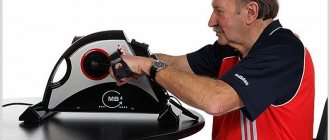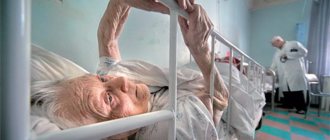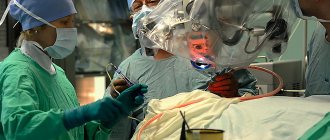A concussion is a form of traumatic brain injury that is characterized by the absence of structural changes. More than 1,000 people are diagnosed with concussions every day. Rehabilitation after concussion is aimed at correcting temporary functional changes.
Specialists at the rehabilitation center, which is part of the Yusupov Hospital, develop comprehensive programs for patients, the implementation of which eliminates neurological pathologies and the consequences of traumatic brain injury, improves performance and mental activity. Rehabilitation after a brain injury and concussion is carried out by rehabilitation doctors at the Yusupov Hospital after highly accurate diagnostics.
Recovery from a concussion
A concussion occurs as a result of injuries and bruises. When the brain comes into contact with the skull in a person, a temporary change in the chemical properties of neurons occurs, as well as a disconnection of signal transmission between synapses, resulting in the development of disorders that can be eliminated by effective rehabilitation after a concussion.
When a person has a concussion, they experience the following symptoms:
- confusion;
- nausea and vomiting;
- increased fatigue, drowsiness;
- headaches, dizziness;
- increased blood pressure;
- memory impairment;
- increased breathing;
- pale skin, which quickly gives way to redness.
For many patients, the relevant question is how long does recovery after a concussion take with an integrated approach. Before starting rehabilitation measures, the patient is examined.
The Yusupov Hospital has modern diagnostic equipment that allows you to identify the consequences of a concussion and begin treatment and recovery after a concussion. Highly qualified specialists allow us to assess the patient’s condition using special scales. When making a diagnosis, in some cases magnetic resonance imaging or computed tomography is performed.
Rehabilitation after a concussion is carried out to eliminate the consequences of the injury, stabilize the patient’s condition, adapt to physical activity and improve the functioning of the vestibular apparatus. At the rehabilitation center of the Yusupov Hospital, experienced exercise therapy instructors, neuropsychologists, physiotherapists and other specialists interact with patients.
Is it possible to fly on a plane with a brain tumor?
If any of you have experience or any information about the following please share.
1. Is it possible (permissible, is it necessary) to carry out chemotherapy on the eve of surgery using the “gamma knife” method?
2. What are the rules for transporting patients with a brain tumor over long distances? Namely, is it possible to fly by plane (to the operation site)?
I apologize if my questions are poorly worded. It's the weekend and I can't find a single competent person within reach, so I'm asking questions here and I really need answers before Monday.
Thank you very much for the information.
Due to various circumstances, I now only have images (tomographic, about fifty-seven of them). They are located here: https://6141726.livejournal.com/
To my great regret, an extract from the medical history and a neurosurgeon’s report are not yet available to me. But soon they will too.
If the specialists visiting this forum would like to take a look at the pictures, I would be very grateful for any information.
Pictures can also be downloaded here: https://homepage.mac.com/aranysh/FileSharing4.html
Just in case. I use Osirix to view (https://homepage.mac.com/rossetantoine/osirix/Index2.html - for Macintosh users)
“I have been sick since the beginning of March 2006. He was examined in the clinic radiographically and endoscopically in a year. Histology dated March 13, 2006—small cell lung. A course of PCT and radiation therapy with a dose of 40 Gy was carried out.
He grew and developed normally. Denies tuberculosis, Botkin's disease, and venous diseases. Allergy history is clear. Hereditary history is not burdened. The general condition is relatively satisfactory. The patient is somewhat inhibited, but answers questions correctly. The skin is of normal color and clean. Peripheral lymph nodes are not enlarged. There is vesicular breathing in the lungs, no wheezing. Heart sounds are muffled. Pulse 84 beats per minute, rhythmic. AD-120/80. mmHg. The tongue is clean and moist. The abdomen is soft and painless. The liver and spleen are normal. Pasternatsky's symptom is negative. Stool and urination are free.
CT scan dated February 22, 2007 - metastasis to the brain.
KBC dated February 22, 2007 - erythrocytes - 4.8x10 12/l, leukocytes - 11.3x10 9/l, hemoglobin - 160 g/l, color index - 1.0, platelets, 320x10 9/l, hemotocrit - 45 ,0, segments - 82, pal. nuclear - 7, esonophils - 1, lymphocytes - 8, monocytes - 2. Blood clotting according to Sukharev - 5 min. 45 sec.
OAM dated February 22, 2007 - yellow color, specific gravity - 1017, acidic reaction, protein - Abs, glucose - abs, leukocytes - 3-5 per floor. sp.
Blood biochemistry dated February 20, 2007 - bilirubin - 13.8 µmol, protein - 78.0 g/l, thymol test 1.0, blood sugar - 7.2 mmol/l, urea - 7.1 mmol/l, creatinine - 74, 4 µmol.
Blood coagulation system dated February 20, 2007 - prothrombin index - 87%, plasma recalcification - 100, fibrinogen - 6.0 g/l, fibrinogen B - positive. Thrombotest - 6 tbsp, ethanol. the test is weak.
ECG dated 02/22/2007 - sinus rhythm, heart rate 90 beats per minute, normal position of the EOS, left ventricular hypertrophy, scar changes in the anterior superior region of the left ventricle.
Blood on RW dated February 23, 2007 - negative
Treatment was carried out - temodal 250 mg per os #5 SD 750 mg, dexamethasone 12 mg IV. Metoclopramide 4.0 IV, sibazon 2.0 ml IM.
The patient was discharged home in satisfactory condition. PCT is recommended after three weeks.
Clinical diagnosis: Central part of the upper lobe of the right lung stSh V T3N0M0. Condition after chemoradiotherapy (6 courses of PCT + RT SOD 40 Gy 2006). MTS in the brain. —————————————————————
The patient, 59 years old, was hospitalized from 10/02/06 to 11/17/06 with a diagnosis of Central heart disease of the upper lobe of the right lung T3NxM0. ST-III. Condition after chemotherapy and 1st stage of radiation therapy. Gist. conclusion dated March 13, 2006: Small cell s-ch.
History of the disease: Considers himself sick since October 2005, when a cough appeared, he was treated at the place of residence, but without effect. After the condition worsened: superior vena cava syndrome developed in March 2006, he underwent a clinical and x-ray examination with a biopsy, the diagnosis was: S-ch of the lung, small cell variant. The patient underwent 6 courses of PCT from March to August 2006. According to the data from the chest organs, there is a significant regression of the process over time. From 09/14/06 to 10/16/06 the 1st stage of radiation therapy was completed. SOD-40 Gr. On the control P - chest organs, stabilization of the process is noted. This hospitalization is associated with the 2nd stage of radiation therapy.
Treatment was carried out: Radiation therapy to the affected area with gamma radiation using the Tergam device ROD-2 Gy once a day SOD 20 Gy. Total SOD - 60 Gy. He tolerated the treatment satisfactorily.
1) UAC (11/14/06): eryth.=4.0x10 12/l; Hb=118.8 g/l; leuk.=4.2x10 9/l; TsPK-0.9; ESR-6 mm/h 2) OAM (10/13/06): beat/weight=102; protein=abs; leuk=unit V. p/z
Recommended: Observation by an oncologist at your place of residence. Follow-up examination after 2-3 months.
02/16/07 Consultation with a professor.
Clinical and radiological examination (dated 02/08/2007) shows complete recession. [Inaudible] to the chemotherapy department to decide on further [inaudible]
Brain scan protocol
Scan thickness 5 mm
Scanning plane: axial, frontal
Contrast agent: not administered
A round formation is identified in the superior parietal region of the left hemisphere
3.0 cm with high signal on FLAIR, T2-weighted images and low on T1-; perifocal edema is pronounced. Local
1.5-2.0 cm structures with a similar signal are visualized in the left occipital lobe, the left hemisphere of the cerebellum, perifocal edema is weakly expressed in the left occipital lobe. The craniocervical junction and brainstem regions do not have local changes. The midline structures of the brain are not displaced. Extracerebral liquor spaces are not expanded. The volume of the cerebral ventricles is not increased.
Conclusion: mts-brain damage. "
Rehabilitation after a brain injury
A brain contusion is also a type of traumatic brain injury, but it differs from a concussion in the tissue damage. People need rehabilitation after a brain injury, as consequences of varying severity may appear.
Comprehensive diagnostics using CT and MRI makes it possible to identify destructuring of brain tissue and begin timely treatment. For patients who come to the Yusupov Hospital with a brain contusion, neurologists and neurosurgeons are developing a treatment program that includes conservative and minimally invasive methods. Rehabilitation after a brain contusion is carried out by highly qualified specialists from the Yusupov Hospital.
Airplane and cancer
You can call the airport for information about what to expect at the security checkpoint.
You can also request a Passenger Support Specialist. These TSA professionals are trained to assist people with disabilities of all types.
Oral medications
Traveling with syringes
Getting around at the airport
Preliminary placement
Reducing the risk of blood clots
Both air travel and cancer increase the risk of blood clots (deep vein thrombosis and pulmonary embolism), and this risk is higher when they are combined. Cancer treatments such as surgery and chemotherapy further increase the risk. Fortunately, many of these clots can be prevented by taking a few precautions:
Concussion: recovery period
Patients recovering from a concussion are interested in how long it takes to resolve the effects of the injury. Rehabilitation at the Yusupov Hospital includes a set of measures individually selected for each patient, so its duration is determined by a specialist.
After a concussion, until the symptoms are eliminated, the patient must follow the recommendations of a specialist:
- maintain a sleep and rest schedule;
- eat rationally;
- limit physical activity and exclude work that requires concentration;
- avoid stress and emotional tension;
- do not drink alcohol.
If a patient is diagnosed with a concussion, recovery of the body should take place under the guidance of an experienced specialist. In some cases, patients require a hospital stay, so comfortable conditions have been created for patients at the Yusupov Hospital.
Cancer and plane fatigue
When you think about your upcoming trip, you may imagine yourself traveling like you did before cancer. Still, cancer fatigue, whether it's the fatigue that most people experience during treatment or that annoying fatigue that lingers long after treatment is complete, can leave you exhausted if you don't plan on extra rest while traveling. You may find it helpful to write down the activities you want to participate in by destination, and then prioritize them as follows:
Something you really want to do
Something you would like to do if you have time
If you list your planned activities this way, you'll be more likely to take part in the activities you most want to do, and hopefully you'll feel less guilty when you need to take a day or two and just rest.
Rehabilitation after a brain contusion at the Yusupov Hospital: benefits
Recovery from brain contusion and concussion is one of the priorities of the Yusupov Hospital Rehabilitation Center. Experienced specialists provide patients with high-quality medical services and create a comfortable psychological environment.
Recovery after a concussion, carried out by specialists at the Yusupov Hospital, has a number of advantages:
- fast and highly accurate diagnostics, allowing to identify the consequences of the injury. The rehabilitation center has a modern material and technical base, which is regularly updated;
- when choosing methods of treatment and recovery, specialists give preference to the safest and most effective means;
- development of an individual recovery plan, including therapeutic and recreational procedures and medication;
- in patients with a concussion, rehabilitation takes place in a comfortable hospital to consolidate the results obtained and comprehensively eliminate the consequences;
- professional care and round-the-clock supervision by medical staff.
Bruises and concussions, for which rehabilitation is mandatory, are most often detected in modern people leading an active lifestyle. The main task of specialists at the Yusupov Hospital when treating patients with traumatic brain injuries is to provide emergency care and subsequent recovery.
Patients experiencing intense symptoms after a fall or various types of injuries can immediately contact the rehabilitation clinic, which is open daily. Pre-registration for an appointment is carried out by employees by calling the Yusupov Hospital.
Author
Treatment
The first priority in treatment is first aid. If a person is unconscious, you need to lay him on his right side; if there are wounds, treat him and apply an aseptic bandage. All patients with TBI should be hospitalized in a hospital, and as their condition improves, they can be discharged for outpatient treatment. In the first three days, patients need bed rest, followed by its gradual expansion. To restore normal functioning of the body, patients need rest, healthy sleep and good nutrition. Treatment is symptomatic.
The main medications prescribed for BMS:
- analgesics (ibuprofen, nimesulide, maxigan, etc.);
- sedatives based on medicinal plants (valerian, motherwort) and tranquilizers (adaptol, afobazole);
- sleeping pills (relaxon, donormil);
- nootropic (nootropil, glycine);
- tonic (ginseng, eleutherococcus);
- drugs that improve cerebral circulation (Cavinton, Sermion, piracetam);
- magnesium-containing products (magne-B6).
No alcohol!
Another important rule: don’t drink alcohol during the flight! You should not aggravate a noise hangover with alcohol, otherwise you will get a migraine. To all the variety of drinks that the flight attendant will offer you, prefer mineral water (still), unsalted tomato juice and green tea. Coffee, sweet nectars and tomato juice with salt contribute to dehydration of the body (despite the fact that the air on board is already too dry, which is why we actively lose moisture through breathing and through evaporation from the skin). But the loss of even 1% of the fluid contained in the body worsens the working conditions of nerve cells and leads to headaches! It won't bother you if you take a couple of sips from a bottle of mineral water every 5-10 minutes. Buy a few of these bottles in the duty free area after you get through security. After all, a couple of plastic cups of drinks and a cup of tea that you will be offered during the flight are clearly not enough to replenish fluid loss.
Why can things get bad on an airplane?
The main cause of many problems associated with the deterioration of the physical condition of passengers during a flight is a significant overload of the vestibular system, compared to the usual everyday state. The pilot's maneuvers during landing and takeoff, the duration of the trip, and overcoming turbulence zones force the nervous system to experience continuous stress, the result of which is reflected both in the functioning of the heart and blood vessels, and in the gastrointestinal tract.
Gradually, the body will get used to the increased stress and the symptoms will disappear, but not everyone wants to spend a long time trying to fight the oncoming symptoms. In addition, a long and unexpected overload of such a plan can negatively affect a person and lead to extremely dangerous conditions for life and health. To ensure that your flight does not result in an emergency visit to the hospital, you should carefully prepare for air travel.
Airplane travel insurance with cancer
Before you book your flight
Once you've figured out whether you need oxygen on a flight, there are a few more steps you can take to ensure a successful trip. First of all, if you are traveling for treatment on a budget, you can get some help. Several organizations provide free air travel for cancer patients who need to travel for treatment.
And keep in mind that oxygen is just one thing to consider before taking to the skies. Check out our list of tips for traveling with cancer to make sure you've covered all your bases.
Is it possible for a cancer patient to fly on an airplane? Features of the flight of cancer patients
People with cancer receive special treatment. Sometimes you have to travel thousands of kilometers for consultations, treatment, or surgery. Exhaustive long-term and daily trips are very difficult to endure. Air travel might not be easier, but at least much faster. The question is: can a cancer patient fly on an airplane?
Air transportation for cancer patients is possible, but permission to fly must be issued by the attending physician. Depending on the disease, the flight has its own characteristics that must be taken into account.
Features of transporting cancer patients by plane
Low pressure on board an aircraft
Airplanes fly at an altitude of 7-12 thousand meters above sea level, the pressure at this distance from the ground is below normal. Naturally, it is increased in the aircraft cabin, but it still remains reduced. As a result, even healthy people experience a lack of oxygen. This may manifest itself as dizziness, drowsiness, nausea, and a feeling of weakness. This risk should be especially taken into account by passengers with cancer of the larynx, lung or bronchi, who are constantly lacking oxygen even on the ground. Therefore, a flight with these oncological diseases must be coordinated with the attending physician, and, if possible, take a can of oxygen with you into the aircraft cabin.
Air expansion
When pressure decreases, air, like any gas, expands.
During takeoff, as the pressure decreases, the air in the paranasal cavity and middle ear expands.
If a healthy person tolerates this phenomenon without any particular inconvenience, then with some health problems (for example, a runny nose), pressure and pain in the ears are noted.
For the same reason, the condition of patients suffering from such rare forms of cancer as cancer of the nasal cavity and paranasal sinuses, as well as ear cancer, may worsen.
Danger may also lie in wait for those who have recently undergone diagnostic procedures or surgical interventions during which air is introduced into the body cavity - these include any operations on the abdomen and chest. If, for example, after being diagnosed with suspected cancer, you are going to return home a few days after such an intervention, do not forget to consult a specialist.
Escort and air ambulance
In most cases, cancer patients are advised to fly on commercial aircraft accompanied by medical personnel.
In this case, in agreement with the airline, resuscitation equipment and oxygen cylinders are placed on board.
Another option, optimal for patients in critical condition, is medical air transportation using a specialized medical aircraft.
Such aircraft are equipped with high-tech equipment, including artificial respiration devices, cardiac monitors and defibrillators, vacuum mattresses, syringe and infusion pumps, which allows emergency medical care to be provided if the patient’s condition worsens during the flight.
Preparing for the flight and recommendations
If there is a need to fly, the time necessary for the patient’s rehabilitation has passed, and the attending physician has given permission, then before the trip it is necessary to monitor blood pressure for several days, doing this at different times of the day and in different situations. Immediately before boarding a plane, if your blood pressure is high, you need to take a medication to lower it.
You need to collect a first aid kit, where to put:
- antihypertensive drugs taken;
- motion sickness remedies;
- sedative;
- thermal water (carry-on baggage allowance is 100 ml) to make you feel better in the dry air of the cabin;
- apparatus for measuring pressure.
Before departure:
- Wear suitable compression garments to increase vascular tone of the lower extremities in conditions of physical inactivity.
- If you have a history of ischemic stroke, you can take blood thinners as prescribed by your doctor.
In flight:
- Avoid drinking coffee and alcohol.
- Periodically leave your seat and walk around the salon.
- If it is not possible to stand up, perform circular movements with your feet on the spot to prevent physical inactivity.
- If a stressful situation occurs, take a sedative in a timely manner, and if your blood pressure increases, take an antihypertensive drug.
- Drink enough water.
By following your doctor's recommendations and paying close attention to your health, you will be able to minimize the risk of another stroke during or after a flight.
Other Possible Problems
Also, do not forget that air travel, unlike travel by rail and road transport, is highly dependent on weather conditions. The likelihood that the flight may be delayed for a long time and that this time will have to be spent at the airport (often not in the most comfortable conditions) is quite high. And if even for a healthy person, such cases of waiting for many hours can worsen their well-being, then what can we say about people weakened by cancer.
It is possible that the airport, due to weather conditions, cannot accept an arriving aircraft, in which case the aircraft can be sent to an alternate airfield, sometimes hundreds of kilometers away from its destination. In this case, it will take a long time to get to the desired clinic or medical center.
Of course, there is not always an alternative to air travel: getting from Moscow to Seoul or New York in a short time by some other means of transport is unrealistic, but if we are talking about much shorter distances, then you need to consider all options and carefully analyze all possible risks in order make the best decision.
Forced immobility
During a flight, a person is forced to remain in a sitting position for a long time, which leads to numbness in the legs, narrowing of blood vessels, and slowing of blood circulation. As a result, blood clots can form in the veins, which, especially if they are relatively large, cause swelling and pain in the lower legs. However, the greatest threat is posed by pulmonary embolism - a condition in which a broken fragment of a blood clot is carried into the lungs by the flow of blood, which causes shortness of breath, chest pain, and in severe cases, death.
Thromboembolism appears several hours or even days after the flight, and the longer the flight, the higher the risk of its development. In addition, a number of factors lead to an increased risk of thromboembolism, including the presence of malignant tumors and recent operations on the abdomen, pelvis, and legs.
If, after weighing all the pros and cons, you still decide to fly, we recommend drinking as much water as possible throughout the flight, changing your position in the seat if possible, and doing simple exercises to contract the muscles of the lower leg. In addition, you should definitely wear compression stockings when flying, which also reduce the risk of blood clots. With the permission of your doctor, you can also advise taking medications that reduce blood clotting.
Features of transportation of cancer patients by air
Air transport is extremely popular among passengers who value above all else the ability to travel vast distances in a matter of hours.
The high speed at which modern aircraft fly is of great importance when it comes to transporting cancer patients.
However, air travel, while well tolerated by most healthy passengers, is often a serious challenge for a person diagnosed with cancer.
The fact is that air travel is always associated with exposure to a number of factors that can negatively affect the condition of the human body, especially if it is weakened by a serious illness. Let's talk about these factors in more detail.











